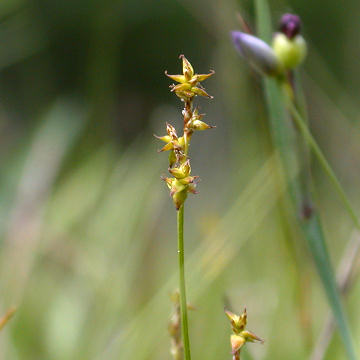

Carex interior - (image 1 of 5)
Taxonomy
Family: Cyperaceae
Section Stellulatae
Habitat
Swamps, bogs, calcareous wet meadows, moist prairies.
Associates
Distribution
Newfoundland and Labrador west to southern Yukon and AK, south to VA, MO, and Mexico.
Morphology
Smooth, tufted perennial to 90 cm; leaves 3-5 per stem, narrow, 1-2.5 mm wide; spikes 2-6, sessile; at least the terminal spike gynecandrous (staminate borne below the pistillate); perigynia mostly 5-15, often spreading or reflexed and usually brown at maturity, nerveless on the ventral face or with a few short nerves ending near the middle, somewhat convexly tapered from the widest point to the conspicuously serrulate margined beak; stigmas 2; achene lenticular.
Notes
Fruiting late May to June
Wetland indicator: OBL
Also called Prairie Star Sedge in the Midwest. Similar to C. atlantica, which has evident nerves on the ventral face of the often wider perigynia and less conspicuously serrulate beaks.
References
Gleason, Henry A. and A. Cronquist. 1991. Manual of Vascular Plants of
Northeastern United States and Adjacent Canada. Second Ed.
The New York Botanical Garden. Bronx, NY
Swink, F. and G. Wilhelm. 1994. Plants of the Chicago Region.
Indiana Academy of Science. The Morton Arboretum. Lisle, Illinois.
|
© Michael Hough 2010 |